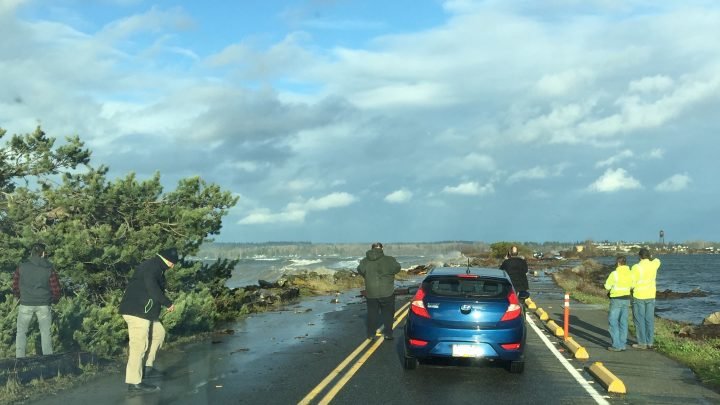 The Semiahmoo Spit was flooded and covered in debris during the storms that occurred in December. By Jami Makan
The Semiahmoo Spit was flooded and covered in debris during the storms that occurred in December. By Jami Makan Sam Castro, assistant public works director for the city of Blaine, said that the city is fortunate to be receiving federal funds for the December storm recovery efforts.
He said that some other cities lack the staff and expertise to be able to tap into federal disaster funding. The process requires the completion of voluminous paperwork, with strict timelines and a tough auditing process.
“I’ve been doing this for 30 years,” he said. “I am well versed in this process, having done this for other cities and counties in the past.”
The first step was for Castro to fill out a FEMA preliminary damage assessment summary report. This report listed the types of damage that Blaine sustained in the storms, and the estimated amount of money required to fix each category of damage. For example, debris clearance was estimated to cost $25,000.
However, this amount paled in comparison to the two major projects that are required as a result of the December storms: power line replacements on Pipeline Road, which could cost $800,000 to fix, and the rehabilitation of Semiahmoo Parkway, which could cost up to $1.3 million to repair. These projects have not yet started.
In order to complete the FEMA report, Castro had to adhere to strict timelines, requiring him to work overtime in order to meet FEMA’s deadlines. Some days he worked up to 16 hours, and he worked on weekends as well. “I knew if I didn’t populate the information about damage estimates right away into a spreadsheet, I wouldn’t be about to meet FEMA’s timelines,” he said.
Each category, such as roads or utilities, had its own FEMA form that needed to be filled out. Castro was required to detail every project that needed to be done as a result of the storms, and the estimated cost of each one. “Every one of those categories has its own form, and has to have its own documentation and estimates,” he said.
A common practice is for cities to hire consultants to complete this type of work, but Castro said that the city of Blaine cannot afford to hire a consultant at this time, and had to get the job done using existing resources and staff.
Castro said that representatives from FEMA later visited Blaine, and he spent eight hours with them to justify his estimates to FEMA’s audit team. “I felt very comfortable that my numbers were accurate,” he said.
His past experience taught him the importance of maintaining his credibility with the federal auditors and supporting his estimates with data and photographs. “Because I was well versed in the process, I knew I had to capture photographs both before and after the storms,” he said.
The next step in the process is for Castro to complete a FEMA request for public assistance form. This form will help start the federal reimbursement process. The federal government is expected to contribute up to 85 percent of the cost of repairs, while Blaine will be on the hook for at least 15 percent. “This is reimbursable money we’re talking about,” said Castro. “We have to first do the repairs with our own money.”
Even though Blaine will have to find the money to pay for repairs while waiting to be reimbursed, he said this is still better than receiving no federal funds at all. There are federal resources out there, and it is important to take advantage of them, he said. Otherwise repairs would not be completed or would have to be paid for completely by local communities.
“If we don’t know the resources that are out there, we are not being resourceful,” he said.
Comments
No comments on this item Please log in to comment by clicking here